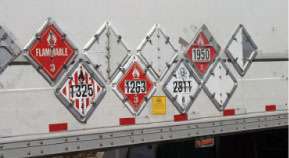ATA backs EOBR proposal – with reservations
Device specs, supporting docs among group’s concerns
The American Trucking Associations told the Federal Motor Carrier Safety Administration it supported the agency’s proposal to require motor carriers to install devices to record drivers’ hours of service electronically, but urged the agency to address device design and performance requirements. Also, ATA raised a number of concerns about the supporting documents component of the proposals, specifically that the agency’s proposal did not meet requirements mandated by Congress.

ATA criticized FMCSA for failing to establish a list of supporting documents that must be retained at a “reasonable cost” to motor carriers.
“The agency must address some of the device design and performance specifications which are critical to the success of such a mandate,” ATA said in comments filed last month. These issues include a more secure driver identification and authentication process and improved standards to ensure the devices are not prone to tampering or fraud.
Electronic logging, ATA said, “will improve compliance with the hours-of-service regulations. This is important since FMCSA data has demonstrated a strong correlation between compliance with the current hours-of-service regulations and safe operations.” ATA has advocated for retention of the current hours-of-service regulations, the subject of a separate rulemaking, in part on the basis of this data.
But ATA had “a number of serious concerns” about the supporting documents portion of FMCSA’s EOBR proposal. “FMCSA’s proposal to require carriers to retain a document (or documents collectively) to verify the beginning and end of each on-duty/not driving time period is unrealistic,” ATA said. “Available documents typically lack such precision. The agency’s suggestion that carriers certify that such documents don’t routinely exist would place those carriers at great risk.”
The agency had proposed that carriers make such certifications, but that they also be automatically subject to the maximum civil penalty if found to have made a false certification. “The agency should establish a finite list of documents that carriers must maintain and declare that those that do so will be deemed to be in compliance,” ATA told the agency.
ATA also criticized FMCSA for failing to establish a list of documents that must be retained at a “reasonable cost” to motor carriers as required by Congress in the 1994 Hazardous Materials Transportation Authorization Act. ATA previously sued the agency for failing to adhere to the 17-year-old congressional mandate.
IN BRIEF
* Legislation introduced in Congress would encourage the use of propane autogas in commercial fleet vehicles by extending provisions in current legislation for propane autogas fuel, propane autogas-powered vehicles and refueling infrastructure through 2016. The 2011 Propane GAS Act (H.R. 2014/S. 1120) includes a 50-cent-per-gallon credit for propane sold for use in motor vehicles and a tax credit to consumers who purchase propane vehicles.
* The Port Authority of New York and New Jersey expanded the eligibility of drayage trucks that can be replaced under the Port Authority Port Truck Replacement Program to include trucks with model year engines 2003 or older. The TRP is a first-come first-serve limited offer to provide grants and financing to help eligible truck owners purchase newer, more environmentally-friendly trucks.
* FreightWatch International’s 2011 supply chain survey showed that cargo theft is the top concern of 81 percent of supply chain professionals over the next five years. Terrorism is the top concern of 11 percent of survey respondents, which comprised all levels of management from transportation providers, third-party logistics firms, manufacturing, insurance companies and others.
* NIP Group’s 2011 first-quarter Transportation Insurance Pricing Survey indicates that while the market remains soft, it has reached stability. Survey participants believe that premiums on all accounts, regardless of fleet size, are mostly flat, with some segments posting mild rate increases.
* Hub Group Inc.’s Comtrak Logistics Inc. subsidiary acquired certain assets of Domestic Transport Inc., a 22-driver intermodal drayage carrier based in Pacific, Wash. Terms were not disclosed.
* Express-1 Expedited Solutions Inc. and Bradley Jacobs, founder of United Rentals Inc. and United Waste Systems, entered into an agreement under which Jacobs and minority co-investors will invest an aggregate of up to $150 million in cash in Express-1. Pending shareholder approval, Jacobs will become Express-1’s majority shareholder, chairman and CEO.
* Roadrunner Transportation Systems, based in Cudahy, Wis., acquired the outstanding stock of Bruenger Trucking, a Wichita, Kan.-based refrigerated truckload company, for about $10.6 million plus an earnout capped at $3 million. During calendar year 2010, Bruenger generated about $23 million in revenues and about $3.5 million in earnings.
* NFI, a Cherry Hill, N.J.-based integrated supply chain solutions provider, acquired the West Coast operation of The Gilbert Co., its second acquisition this year; terms were not announced. NFI says the six additional facilities in California’s Inland Empire expand its warehouse space to 7 million square feet in the region and 21 million square feet nationwide.
* Ryder acquired Bradford, England-based Hill Hire – a Lloyds Banking Group subsidiary and a U.K. market provider of commercial truck leasing, rental and maintenance – for about $252 million. The acquisition includes 4,000 heavy-duty vehicles, a large trailer fleet, 13 vehicle maintenance facilities and a 300-employee work force, including maintenance technicians.
* The National Tank Truck Carriers elected Gregory Hodgen chairman. Hodgen, president and chief operating officer of Groendyke Transport Inc., succeeds Steven Rush, chief executive officer of Carbon Express Inc., who now chairs NTTC’s executive committee.
Drivers, carriers must keep copies of medical data for now
The Federal Motor Carrier Safety Administration proposed to keep in effect until Jan. 30, 2014, the requirement that interstate drivers subject to commercial driver’s license regulations and federal physical qualification requirements must retain a paper copy of the medical examiner’s certificate. In addition, interstate motor carriers also would be required to retain a copy of the medical certificate in the driver qualification files.

Under FMCSA’s proposal, interstate motor carriers would continue to be required to retain a copy of a driver’s medical certificate in the driver qualification files through January 2014.
FMCSA says the Notice of Proposed Rulemaking was issued to ensure the medical qualification of CDL holders until all states are able to post the medical self-certification and medical examiner’s certificate data on the Commercial Driver’s License Information System driver record. But the proposed rule would not extend the mandatory dates for states to comply with the requirement to collect and to post to the CDLIS driver record data from a CDL holder’s medical self-certification and medical examiner’s certificate.
On Dec. 1, 2008, FMCSA published a final rule requiring any CDL holder subject to the physical qualification requirements of the Federal Motor Carrier Safety Regulations to provide a current original or copy of his or her medical examiner’s certificate to the issuing state driver licensing agency. FMCSA also now requires the SDLA to post in the CDLIS driver record the self-certification that CDL holders are required to make regarding applicability of the federal physical qualification requirements and, for drivers subject to those requirements, the medical certification information specified in the regulations.
Those requirements have a compliance date of Jan. 30, 2012, but FMCSA says several SDLAs recently have advised the agency that they may not have the capability by that date to receive the required medical certification and medical examiner’s certificate information provided by a nonexcepted interstate CDL holder, and then manually post it to the CDLIS driver record. Inability of an SDLA to receive the required material would render both the CDL holder and his or her employer unable to demonstrate or verify, respectively, that the driver is medically certified in compliance with the FMCSRs.
FMCSA says it believes that extending the requirement to retain the paper copy of the medical examiner’s certificate by both the interstate CDL holder and the motor carrier for two years will provide sufficient time for both to be sure that all SDLAs will be obtaining the medical status and medical examiner’s certificate information and posting it on the driver’s CDLIS driver record. For more information, go to www.regulations.gov; the docket number is FMCSA-1997-2210.
Safety researcher questions FMCSA HOS studies
The American Trucking Associations last month said an internationally recognized safety researcher questioned the cache of studies submitted in an 11th-hour manner by the Federal Motor Carrier Safety Administration to support its hours-of-service proposal, saying the studies contain many problems and shouldn’t be relied on to support the agency’s proposed changes.
Dr. Ronald R. Knipling, former head of FMCSA’s research division, called into question the validity of studies the agency inserted into the docket on May 6 after closing the comment period for its Notice of Proposed Rulemaking. (FMCSA later reopened the comment period for 30 days for discussion related only to the new documents.)
Specifically, Knipling raised “fundamental criticisms” of a study conducted by researchers at Pennsylvania State University, concluding that the sample of drivers, trucks and crashes, as well as minimal attention paid to other factors in crashes, rendered the study of little value. “It would be erroneous and unwarranted to accept Penn State’s principal findings and conclusions without extensive reanalysis, internal validation and external replication,” he wrote.
Similarly, Knipling said a study by the Virginia Tech Transportation Institute was lacking and concluded that “more probing and self-challenging analyses must be performed before [the] study[’s] findings can be accepted as sound science.” Regarding a study of Florida transit bus drivers, Knipling concluded that the “significant differences between Florida’s transit bus operator work rules and those for interstate truck drivers render schedule-related research findings for one largely inapplicable to the other.”
Bill Graves, ATA president and chief executive officer, said Knipling’s review of FMCSA’s studies underscores the weakness of the agency’s case for changing the hours-of-service rules. “For a third time since FMCSA began this ill-advised revision of the hours-of-service rule, an expert in the field of truck safety has called into question the science FMCSA is using to advance these unwarranted changes,” Graves said. “We have said from the beginning that changes to the rule must be made based on sound science and hard evidence, not political motivations.”
FMCSA and safety advocacy groups had negotiated in court a July 26 deadline for the agency to issue a new final hours-of-service rule, but the agency said it would not be able to meet that deadline after reopening the comment period to allow for review and discussion of the new studies and its possible consideration of their findings in the development of the final rule. FMCSA and petitioners agreed to a new Oct. 28 deadline.
EPA calls for improved SCR guidelines
The U.S. Environmental Protection Agency updated its guidance for certification of truck engines using selective catalytic reduction to reduce emissions, calling on SCR engine makers to continue developing warning systems that alert drivers when the truck’s diesel exhaust fluid tank is nearly empty or filled with a liquid other than DEF. The new guidance, mostly in response to claims made by Navistar Inc. that SCR technology can be circumvented, also urged OEMs using SCR to research methods that would inhibit tampering with SCR system operation and incorporate further inducements for drivers to comply.

EPA’s guidance urged OEMs using selective catalytic reduction to research methods that would inhibit tampering with SCR system operation and incorporate further inducements for drivers to comply.
Navistar had sued both EPA and the California Air Resources Board over their acceptance of SCR technology without stronger measures to prevent engine operation without DEF or an operational SCR system. The truck maker last year settled both lawsuits by garnering a commitment for further review.
Research cited by Navistar was conducted by EnSight, an independent environmental consulting firm, using two long-haul vehicles and one heavy-duty pickup, all of which used SCR. According to Navistar, EnSight’s research showed that when liquid urea was not present, there was little or no effect on the vehicles’ operations.
However, EPA said testing of SCR systems had yielded mostly positive results. While the agency said Navistar’s findings arose from intentional attempts to circumvent the SCR system, it said that the majority of operations using SCR were in compliance.
EPA’s guidance was published June 7 in the Federal Register; for more information, go to www.gpo.gov/fdsys/pkg/FR-2011-06-07/html/2011-13851.htm.
FUEL SAVVY
New fuel economy labels coming to showrooms
The U.S. Department of Transportation and the U.S. Environmental Protection Agency last month unveiled new fuel economy labels designed to help consumers take advantage of the increased efficiency standards starting this year. The revamped labels are designed to provide more comprehensive fuel efficiency information, including estimated annual fuel costs and savings, as well as information on each vehicle’s environmental impact.
The new labels are designed to underscore the benefits of the passenger car and truck fuel economy rule adopted by EPA and DOT in 2010 and to give consumers better, more complete information to consider when purchasing new vehicles that are covered by the increased fuel economy standards.
Starting with model year 2013, the new labels will be required to be affixed to all new passenger cars and trucks, including conventional gasoline- and diesel-powered cars and trucks, hybrids and electric vehicles. Consumers will see the new labels in showrooms early next year, when 2013 models begin arriving. Automakers also may voluntarily adopt the new labels earlier for model year 2012 vehicles.
“Our new fuel economy and environmental labels are a win for automobile consumers and for the nation’s energy independence,” says U.S. Transportation Secretary Ray LaHood. “These labels will provide consumers with upfront information about a vehicle’s fuel costs and savings so that they can make informed decisions when purchasing a new car.”
President Obama directed DOT and EPA to prioritize the development of new fuel efficiency and greenhouse gas emissions standards, resulting in the standards that will be represented by the new labels. DOT and EPA say the 2010 fuel economy rule, developed with input from major automakers, environmental groups and the states, will dramatically increase the energy efficiency of cars and trucks built in model years 2012 through 2016, saving 1.8 billion barrels of oil over the life of the program and the average consumer $3,000 in fuel costs.
This month, the administration plans to finalize the first-ever national fuel economy and GHG emissions standards for commercial trucks, vans and buses built in 2014 to 2018. DOT and EPA say these standards are expected to save hundreds of millions of barrels of oil over the life of the vehicles covered and promote the development and deployment of alternative fuels, including natural gas. The administration also is developing the next generation of joint fuel economy and GHG emissions standards for model year 2017-2025 passenger vehicles and expects to announce the proposal in September.
“The EPA and DOT are creating a new generation of fuel economy labels to meet the needs of a new generation of innovative cars,” says EPA Administrator Lisa Jackson. “Today’s car buyers want the best possible information about which cars on the lot offer the greatest fuel economy and the best environmental performance. The new labels provide comprehensive information to American car buyers, helping them make a choice that will save money at the gas pump and prevent pollution in the air we breathe.”
Withdrawal of hazmat loading/unloading proposal sought
In comments filed with the Pipeline and Hazardous Materials Safety Administration, the American Trucking Associations asked the agency to withdraw its proposal to regulate the loading and unloading of hazardous materials in order to conduct needed research. “ATA supports PHMSA’s efforts to reduce loading and unloading incidents,” says Richard Moskowitz, ATA vice president. “However, we cannot support the proposed rule as written on the grounds that it will frustrate motor carriers’ ability to comply with the hazardous materials regulations, makes it unlikely that drivers will be properly trained and its costs will far exceed its benefits.”

PHMSA’s proposal would require additional training for employees and new safety requirements for motor carriers and facilities that transfer hazardous materials to and from rail cargo and highway cargo trucks.
PHMSA on March 10 published a Notice of Proposed Rulemaking that would require additional training for employees and new safety requirements for motor carriers and facilities that transfer hazardous materials to and from rail cargo and highway cargo trucks. PHMSA says its data show that the most dangerous part of transporting hazardous materials by highway cargo trucks and by rail occurs when the hazardous material is being transferred by hose or pipe between the holding facility and the rail or truck transporting it, and that human error and equipment failure also cause the greatest number of incidents during loading and unloading operations.
The NPRM would require practice drills and classroom training of truck drivers and other workers who unload or load hazardous material, training on automatic valve shutdown to ensure the systems are in place and that employees know how to use the systems, and developing inspection and maintenance programs to ensure the safety of hoses, valves and other equipment used in loading and unloading.
Over the past 10 years, fatal and serious accidents during the process of transferring hazardous materials between rail or trucks and holding tanks prompted two related recommendations from the National Transportation Safety Board and one from the Chemical Safety Board.
Moskowitz told PHMSA that the goals of the latest proposal “could be best achieved through standardized regulations applicable to loading and unloading for carriers and by requiring facility operators to address and remain responsible for managing unique conditions at their facility. … PHMSA should withdraw the proposed rule and begin an evaluation of regulatory requirements to address the specific causes of loading and unloading incidents.”











